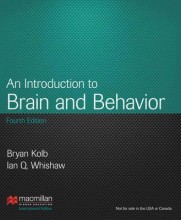Samenvatting: Introduction To Brain And Behavior | 9781464118999 | Bryan Kolb
- Deze + 400k samenvattingen
- Een unieke studie- en oefentool
- Nooit meer iets twee keer studeren
- Haal de cijfers waar je op hoopt
- 100% zeker alles onthouden
Lees hier de samenvatting en de meest belangrijke oefenvragen van Introduction to Brain and Behavior | 9781464118999 | Bryan Kolb
-
1 What are the origins of brain and behavior?
-
1.1 Neuroscience in the Twenty-First Century
Dit is een preview. Er zijn 9 andere flashcards beschikbaar voor hoofdstuk 1.1
Laat hier meer flashcards zien -
Waarvoor zorgt somatic division (SNS)?
Zintuigelijke info en bewegelijke info doorsturen
-
Waarvoor zorgt autonomic division (ANS)?
Interne organen
-
Wat zegt Eibl Eibelsfeldt over gedrag?
Gedrag bevat patronen in tijd (bijv. bewegingen, geluiden, denken)
-
Wat is relatief gefixeerd gedrag?
Onafhankelijk aangeboren gedrag
-
Uit welke drie grote structuren bestaat het brein?
- Forebrain = cerebrum
- Cerebellum = little brain
- Brainstem -
De forebrain bestaat uit verschillende lobes. Welke?
Vuist maken van rechterhand en hand 90 graden naar links draaien:
- Temporal lobe = de duim
- Occipital lobe = de pols
- Parietal lobe = de knokkels
- Frontal lobe = vingers -
Wat houdt MCS in? (Minimally conscious state)
Een conditie waarin een persoon niet bewust is, op bepaalde basisgedragingen, zoals lachen, na. -
Wat houdt PVS in? (Persistent vegetative state)
Een conditie waarin een persoon leeft, maar niet in staat is om te communiceren of zelf te functioneren. -
1.2 Perspectives on Brain and Behavior
Dit is een preview. Er zijn 4 andere flashcards beschikbaar voor hoofdstuk 1.2
Laat hier meer flashcards zien -
Wat is psyche of soul?
Synoniem voor verstand, de ziel (bron van gedrag) leeft voor na de dood.
-
Hoe worden nieuwe eigenschappen geselecteerd?
* voorkomen van een nieuwe eigenschap (mutatie)
* eigenschap vergroot reproductief succes
* dit vergroot de kans op overleving
* eigenschap wordt doorgegeven op nakomelingen
- Hogere cijfers + sneller leren
- Niets twee keer studeren
- 100% zeker alles onthouden
Onderwerpen gerelateerd aan Samenvatting: Introduction To Brain And Behavior
-
What are the origins of brain and behavior?
-
How does the nervous system function?
-
What are the nervous system's functional units?
-
Electrical activity on the membrane
-
How neurons integrate information
-
How do neurons use electrochemical signals to communicate and adapt?
-
How do - Principles of psychopharmacology
-
How do - Grouping psychoactive drugs
-
How do - Factors influencing individual responses to drugs
-
How do - Explaining and treating drug abuse
-
How do - Hormonen
-
How do we study the brain’s structure and functions?
-
How does the Nervous System Develop and Adapt?
-
How do we sense, percieve and see the world? - Nature of sensation and perception
-
How do we sense, percieve and see the world? - Funtional anatomy of the visual system
-
How do we sense, percieve and see the world? - Perception of shapes and colour
-
How do we hear, speak and make music? - Functional anatomy of the auditory system
-
How do we hear, speak and make music? - Anatomy of language and music
-
How does the nervous system respond to stimulation and produce movement? - Hierarchical control of movement
-
How does the nervous system respond to stimulation and produce movement? - Organization of the motor system
-
How does the nervous system respond to stimulation and produce movement? - The basal ganglia and the cerebellum
-
How does the nervous system respond to stimulation and produce movement? - Organisation of the somatosensory system
-
What causes emotional and motivated behavior?
-
How do we learn and remember? - Taxonomy of memory
-
Neural systems underlying explicit and impicit memories - Neural circuit for explicit memories - Hippocampus and spatial memory
-
How does the brain think? - Cognition and the association cortex
-
How does the brain think? - Cerebral asymmetry in thinking
-
What happens when the brain misbehaves?






























